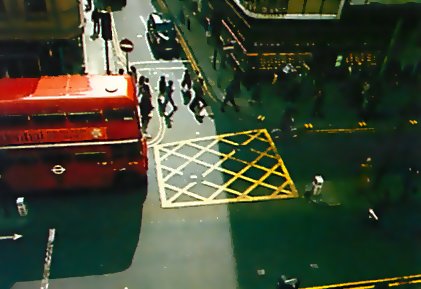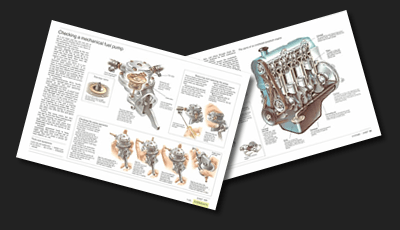Box-grid junctions
These have a box in the middle which is criss-crossed with yellow lines. You should never enter the boxed part of the junction unless you can see an exit.
This is to create a clear area that traffic can always get through.
The road junction is a zone where care and judgement are always needed. There are many different junctions - from T-junctions and crossroads to complicated town centre road patterns - but they all operate on the same basic principle of giving priority to certain roads or traffic streams, as indicated by signs and markings.
A driver who wants to change from a lower priority road to a higher priority one must exercise care at any junction, but even motorists travelling on the major road need to drive with caution.
Markings
This video course is the best way to learn everything about cars.
Three hours of instruction available right now, and many more hours in production.
- 4K HD with full subtitles
- Complete disassembly of a sports car
Road markings and signs like this mean you have to give way to traffic on the other road.
The majority of junctions are marked with a Give Way sign indicating ahigher priority road ahead, together with a warning triangle and white lines painted on the road surface at the junction. 'Give Way' tells a driver to delay entry to a main road until it is clear. The driver does not necessarily need to come to a halt if the way is clear.
An unbroken line across the road plus a Stop sign mean that you have to stop in any case.
The Stop sign demands that the driver on the minor road come to a halt at the junction - whatever the traffic conditions.
Traffic lights and roundabouts do not have Stop or Give Way signs; instead, they are more likely to have route signs posted well forward of the junction - especially on medium-size roads or larger.
Motorway junctions have countdown posts leading up to slip roads off the carriageway, and when pass-
ing a slip road you will see the reflective markers on the road surface to the left of the left-hand lane change in colour from red to green.
Approach
Hazardous crossings
The most dangerous type of junction is tht where a minor road meets a dual carriageway that has cars travelling at high speed. Apart from those vehicles crossing the dual carriageway, others are joining and leaving at the same place. Slip road junctions on to a carriageway are also difficult. They can cause bunching in the traffic stream and may lead to sudden braking.
As you approach any junction, try to take in its whole layout so that you know where you are going and so that you can assess which routes other vehicles are likely to take. Then, in good time so you won't have to cut across anyone at the last minute, use the Mirror-Signal-Manoeuvre discipline to position yourself correctly.
Great care is needed to assess when the junction zone is safe to enter, as other vehicles may appear from other angles without warning. Drivers queueing to leave a minor road may be watching for gaps in the oncoming traffic more closely than they are watching the car ahead of them. When it starts to move, they move too - but fail to notice it stop again.
Try to get inside the filter lane early when turning right, or you could block the road for others.
When waiting to enter a roundabout, much the same situation can happen - the driver of the second car in the queue sees a gap in the traffic and moves out to take it, assuming that the driver in front has already done the same. Of course this is not always the case. Recheck the position of the car in front - just a quick glance is enough - before you pull out. It may avoid an embarrassing accident.
Stationary traffic and hedges can block your view when you are trying to turn right out of a junction.
Once you enter the junction, be positive and get through it as quickly as the traffic conditions allow. As soon as you are in the new traffic flow, check your mirrors to see what's behind and adjust your speed to suit. Never stop in the middle of a junction, except in an emergency.
Country roads
Panel vans turning right at swept junctions may have to pull left for visibility - watch their indicators.
In the country, hazards are often hidden - literally. Give Way signs are often obscured by overgrown hedges or dips in the road while junctions themselves can be hidden by tall grass.
Failure to judge the speed of oncoming traffic causes many accidents at these junctions. If in doubt, wait - there's no point in pulling out ahead of a single vehicle if there's a long, clear space behind. It may cause the oncoming driver to skid or swerve if you underestimate his speed and pull out.
When two cars turn right at traffic lights, they should pass offside-to-offside.
Cycle junctions
In some towns there are traffic light-controlled junctions that have a priority for cyclists. There are two sets of lights at the junction, spaced about 16ft (5m) apart. Cars should stop at the first set of lights, while cyclists are allowed right up to the junction at the second set of lights.
The idea is to give cyclists a chance to get clear of cars and away first, out of danger—especially important when they are turning left because many accidents happen this way.
If you see double sets of lights with markings on the road, look out for the signs mounted on the poles of the first lights, explaining the procedure at that junction.




